How to make the best homemade body butter with 2 simple, natural ingredients. This DIY whipped body butter feels luxurious and delivers maximum moisture to the skin. Let me show you how to make non-greasy body butter that works for any skin type.
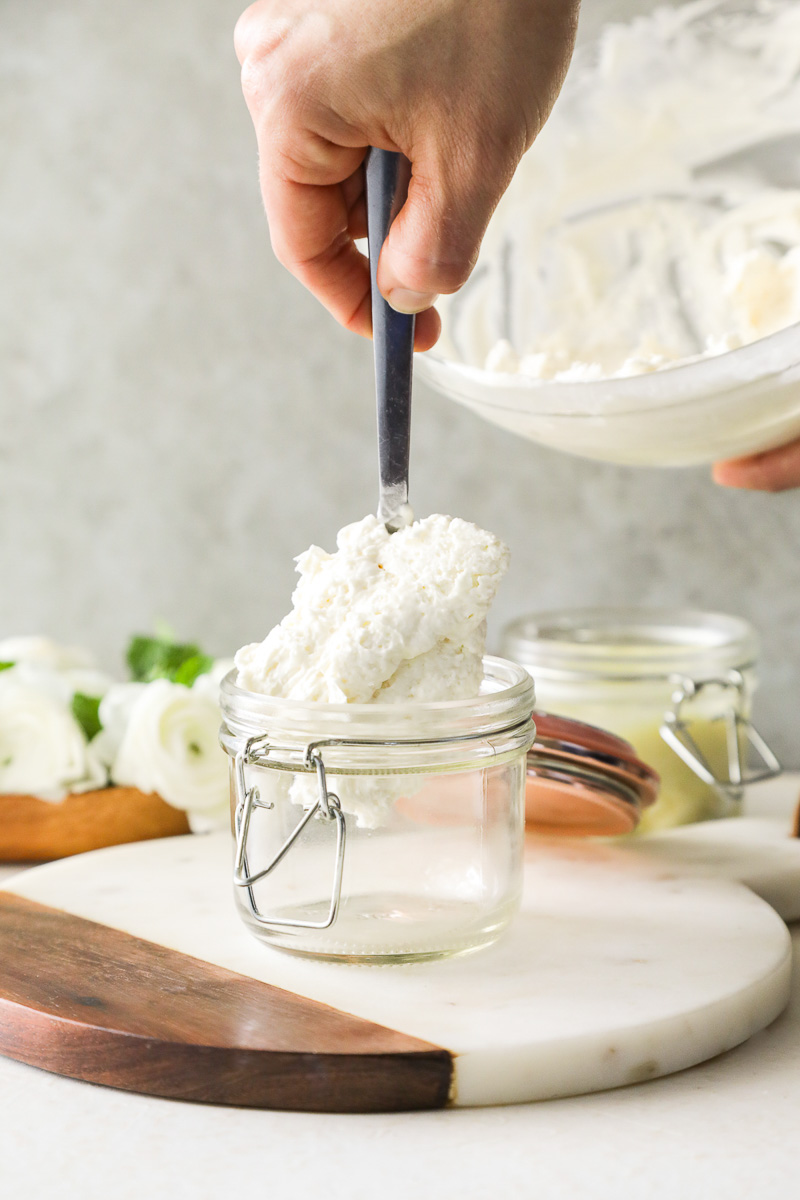
Want to Save This Article?
Enter your email & I’ll send it straight to your inbox. And you’ll get new recipes & tips each week.
Body butters are no strangers to Live Simply. First, we made this ultra-moisturizing shea butter lotion. Then we made a simple lip balm and shea butter cream facial moisturizer.
Today, we’re making silky smooth body butter for the whole body: face, arms, legs, wherever you need moisture.
In this post, I’ll guide you through making homemade body butter via photos and a video.
Key Takeaways
- Simple Ingredients – You’ll need skincare butter (shea butter, mango butter, or cocoa butter), carrier oil, and two optional ingredients- arrowroot starch/flour (to reduce the greasy feel) and essential oil.
- Easy to Make – Melt the ingredients, chill in the fridge, then use a fork or hand mixer to whip. That’s it!
- Inexpensive – Body butter can cost a fortune if you buy it at the store, particularly from a natural company. Making body products, like body butter, is usually cheaper. Buying the ingredients is an extra cost, but once you have them, you can create multiple jars of your whipped body butter (and other products).
- Non-Toxic and Natural – No synthetic fragrances, preservatives, or other unwanted ingredients. Just nourishing ingredients that are good for your skin.
- Shelf Life – 6 months
What is Body Butter?
- Moisturizing – Body butter is a rich, moisturizing skincare product made with skincare butter like shea butter and cocoa butter.
- Lotion Alternative – Body butter can be used as an alternative to lotion since its primary job is to moisturize the skin.
- Full Body Use – It may be used on the entire body, from the face to the feet.
Lotion vs. Body Butter: What’s the Difference?
- Lotion is made with water and oil (and possibly butters) so it’s light, airy, and silky smooth. Homemade lotion needs to be used within a short time or a preservative should be used (due to the water and bacterial growth). It also requires an emulsifier to properly blend the oil and water.
- Body butter is made exclusively with butter(s) and oil(s), so it’s thick and dense. Homemade body butter will last for up to 6 months without a preservative.
Both body butter and lotion are used in the same way: to moisturize the skin. Body butter does deliver more moisture since it’s not cut with water. So it’s ideal for all skin types, particularly dry skin or during the winter months.
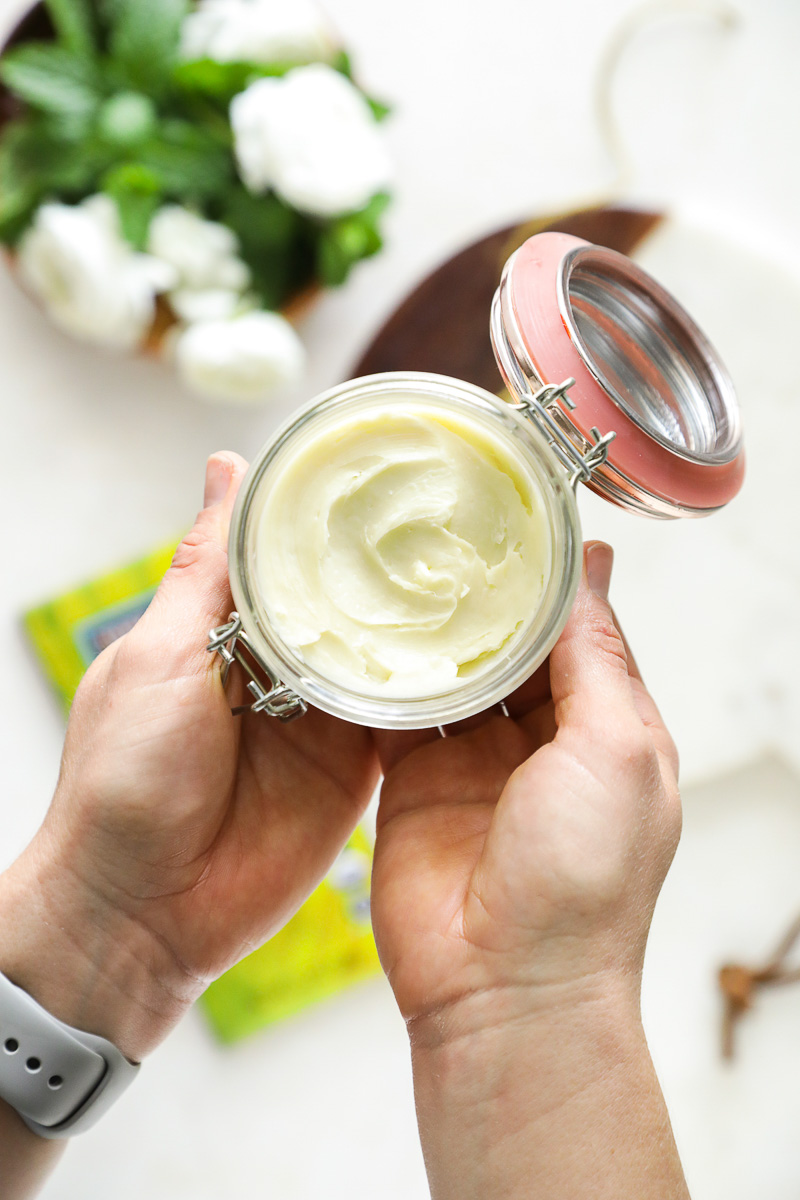
Before You Get Started: Ingredients & Equipment
DIY body butter is easy to customize to your liking. You’ll need just 2 natural ingredients.
From there, you’re welcome to add 2 additional ingredients, if desired, to make a non-greasy product or add a custom scent.
- 1/2 cup skincare butter – provides much of the moisturizing relief. Choose one of these options for the body butter: cocoa butter (hydrating and rich in vitamin E, chocolatey scent), shea butter (rich in fatty acids, vitamin E, ultra-moisturizing), or mango butter (rich in fatty acids, ultra-moisturizing).
- 1/4 cup carrier oil – nourishes and moisturizes the skin. My favorite oil options are sweet almond, olive, sunflower, avocado, jojoba, grapeseed, and coconut oil.
- 1 1/2 teaspoons arrowroot flour starch (optional) – a natural starch that helps to reduce the oily/greasy feel by absorbing.
- 36 drops favorite essential oils (optional) – add an essential oil of choice for the amazing scent.
The ingredients may be found online, some craft stores, or health food stores.
Equipment
- small saucepan – used to create a double boiler by adding water to the saucepan and placing a heat-safe bowl on top. This method protects the fragile ingredients from burning.
- glass or metal bowl (large enough to fit on top of the saucepan) – to melt the ingredients, used with the saucepan to create a double boiler.
- fork or hand-mixer – use to whip the ingredients into a spreadable butter.
- fridge – to cool the ingredients once melted.
- glass storage jar – for storing the final product.
Learn More About Each Ingredient
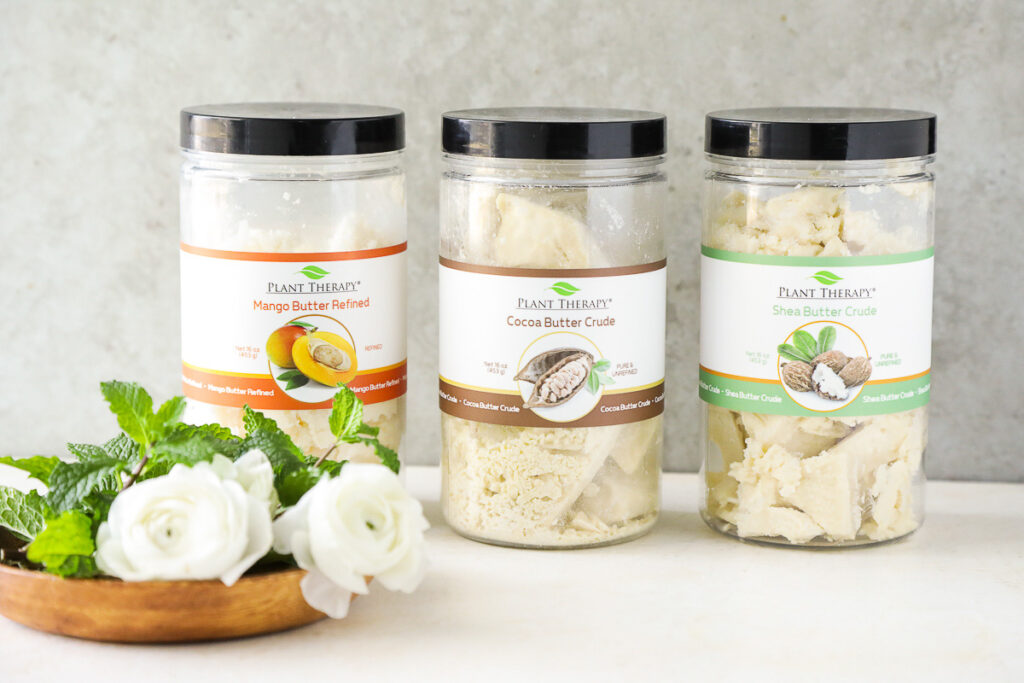
1. Butter
Homemade body butter starts with a moisturizing skincare butter. Shea butter is the perfect base butter since it’s soft, easy to work with, and melts into your skin. My recipe calls for at least a 1/4 cup of shea butter.
From there, it’s up to you, the maker, to customize the body butter. You’ll need a total of 1/2 cup of butter. So use all shea butter (for a total of 1/2 cup shea butter), or mix the shea with a different butter: 1/4 cup of cocoa butter or 1/4 cup of mango butter.
Best Butters
- Shea Butter: Shea butter comes from the “nut” (or pit) of the fruit found on the Karite Tree. It has a strong scent when it’s purchased in an unrefined state. I use unrefined shea butter in recipes (including body butter). If you don’t care for the strong scent, use refined shea butter instead. Since shea butter is naturally soft, it makes a wonderfully soft whipped body butter. It may be used on its own with a carrier oil, or combined with another butter like cocoa butter or mango butter. See all the ways you can use shea butter to make your own body products.
- Cocoa Butter: Cocoa butter comes from cocoa beans, so it has a strong scent and smells like chocolate. Cocoa butter is hard at room temperature, and it melts easily. Cocoa butter is naturally hard and dense, so if you use it, mix it with shea butter or mango butter to make a softer body butter. See other ways to use cocoa butter to make your own body products.
- Mango Butter: Mango butter comes from the seed of mango fruit. It’s naturally soft, similar to shea butter, and can have a gritty texture before melting. It yields a soft, airy body butter when mixed with shea butter. If you don’t want to use shea butter (due to allergies) in my recipe, then mango butter is the best replacement.
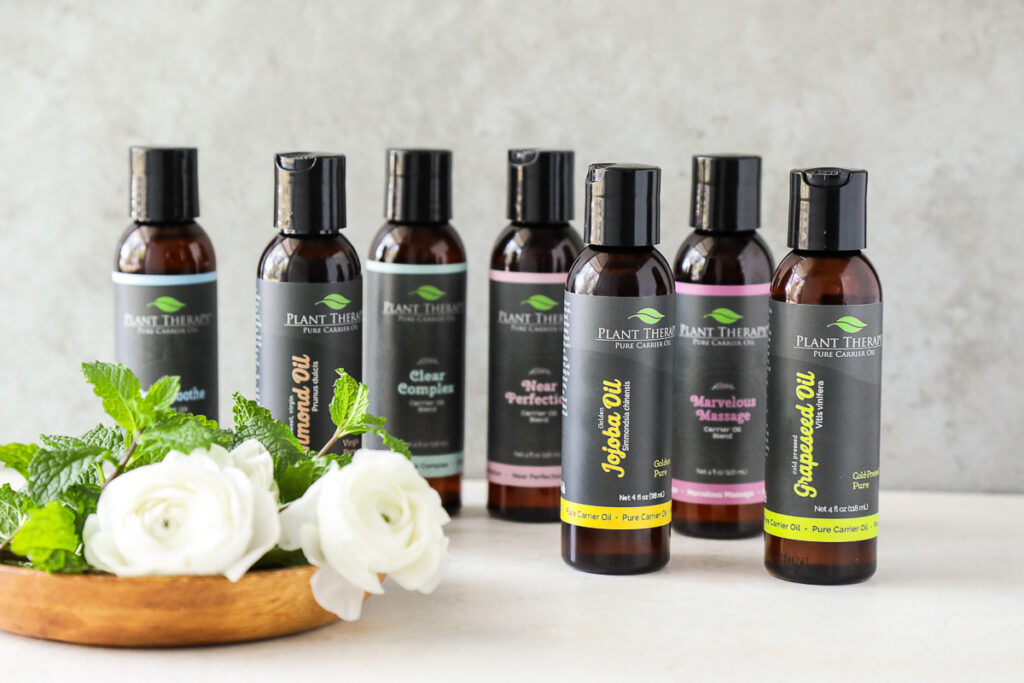
2. Carrier Oil
A liquid oil is the second main ingredient used to make body butter. The oils used in skincare recipes are known as carrier oils, although I usually call them nourishing oils. The oil used is entirely up to you.
See all the ways to use carrier oils to make your own body products.
Best Carrier Oils
- Sweet almond oil, jojoba oil, or grapeseed oil are best for making a non-greasy body butter that is easily absorbed by the skin. Great for all skin types.
- Virgin coconut oil may be used, but it can be very greasy and clog pores. Avoid if you have body acne or sensitive skin.
- Olive oil is another option; however, olive oil can be extremely heavy and feel greasy. Just like with coconut oil, this is not an option for all skin types and you may not love the results.
3. (Optional) Arrowroot Powder
Whipped body butter recipes can be very greasy!
The good news is that there’s a simple solution for this issue: add arrowroot flour/starch. Arrowroot is a natural starch (used in cooking to thicken soups, sauces, and stir-fry) that will absorb the greasy feel of the butters and oils, without drying out your skin.
Substitution: Some folks use tapioca starch and cornstarch (which are similar to arrowroot starch); however, I haven’t used these ingredients so I can’t speak to their success.
4. (Optional) Essential Oils of Your Choice
An essential oil may be added for scent and additional skincare benefits. Use just one essential oil, mix a few essential oils to create different scents, or an essential oil blend (a pre-blended bottle of essential oils). Currently, my favorite essential oils for body butter are lavender, geranium, and frankincense (carteri).
I use a 1% dilution in my body butter recipe. Before using any essential oil, read the back of the bottle for specific dilution recommendations.
Recipe Tutorial Video
How to Make Whipped Body Butter: Step By Step Guide
- Step 1: Melt the Butter in a Double Boiler. Partially fill a saucepan with water (about 1/4 of the way full). Then, place a glass (or metal) bowl on the saucepan. Place the butter(s) in the glass bowl. Turn the stovetop to medium heat, placing the double boiler on top of the heat. Allow the butter(s) to melt (about 3-5 minutes) fully.
- Step 2 Combine Oil & Carrier Oil – If you plan to use arrowroot flour, whisk the flour into the carrier oil in a small bowl. Set the mixture aside. If you’re not using arrowroot flour, skip this step.
- Step 3 Combine the Melted Butter & Oil – Carefully remove the bowl (with the melted butter inside) from the double boiler setup. Add the oil (with the arrowroot flour, if using) to the melted butter, and use a spoon to stir and combine the ingredients.
- Step 4 Chill – At this point, the oil mixture should be cooler (along with the glass bowl). If not, allow it to rest for a few minutes. Then, place the mixture in the fridge and allow it to solidify (about 30 minutes to 1 hour).
- Step 5 Add Essential Oil – Once the mixture is opaque and a bit firm (not solid as a rock), remove the bowl from the fridge. Add the essential oil of choice if desired. The essential oils must be added when the mixture is cool, as heat will cause the fragile essential oils to evaporate.
- Step 6 Whip – If you used cocoa butter, whisk the mixture with a fork until it appears “whipped.” If you used shea and/or mango butter, you can use the same technique with a fork or a hand mixer to “whip” the body butter. Just be careful not to over-whip the mixture.
- Step 7 Spoon Into a Jar – Scoop the mixture into a jar and place the lid on the jar. Now it’s ready to use!
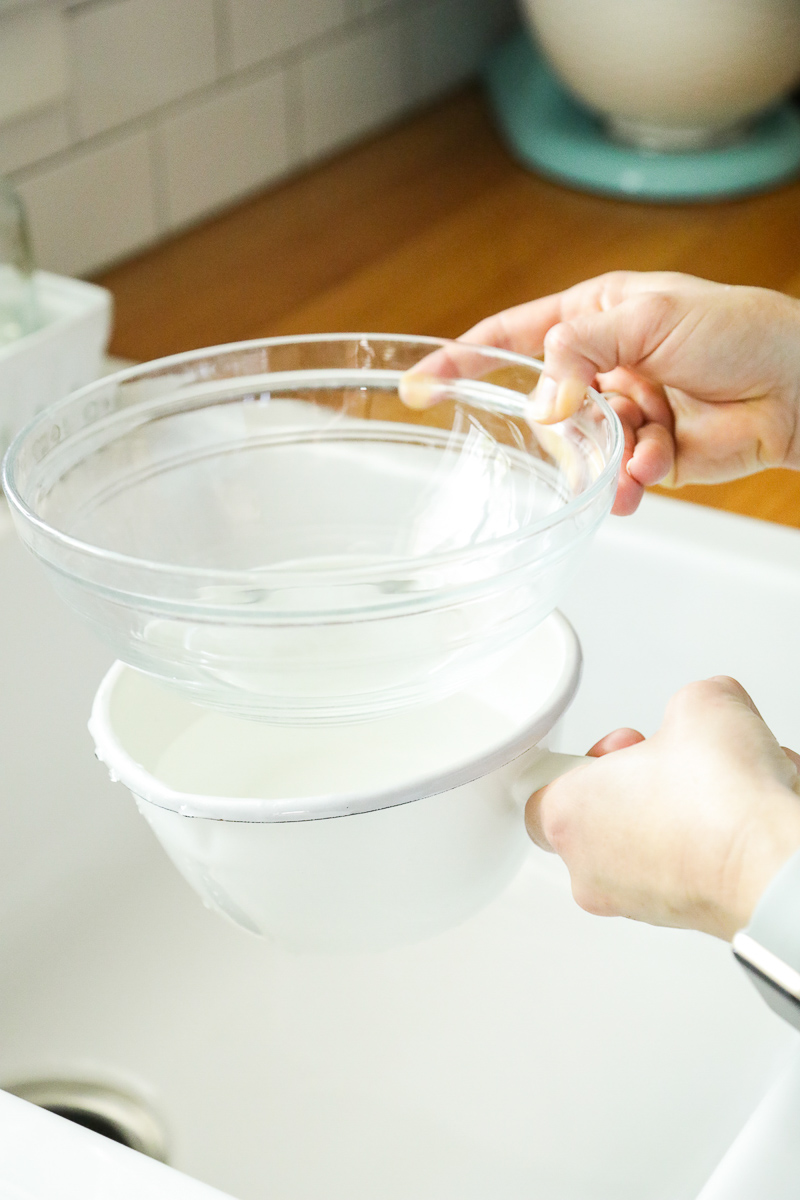

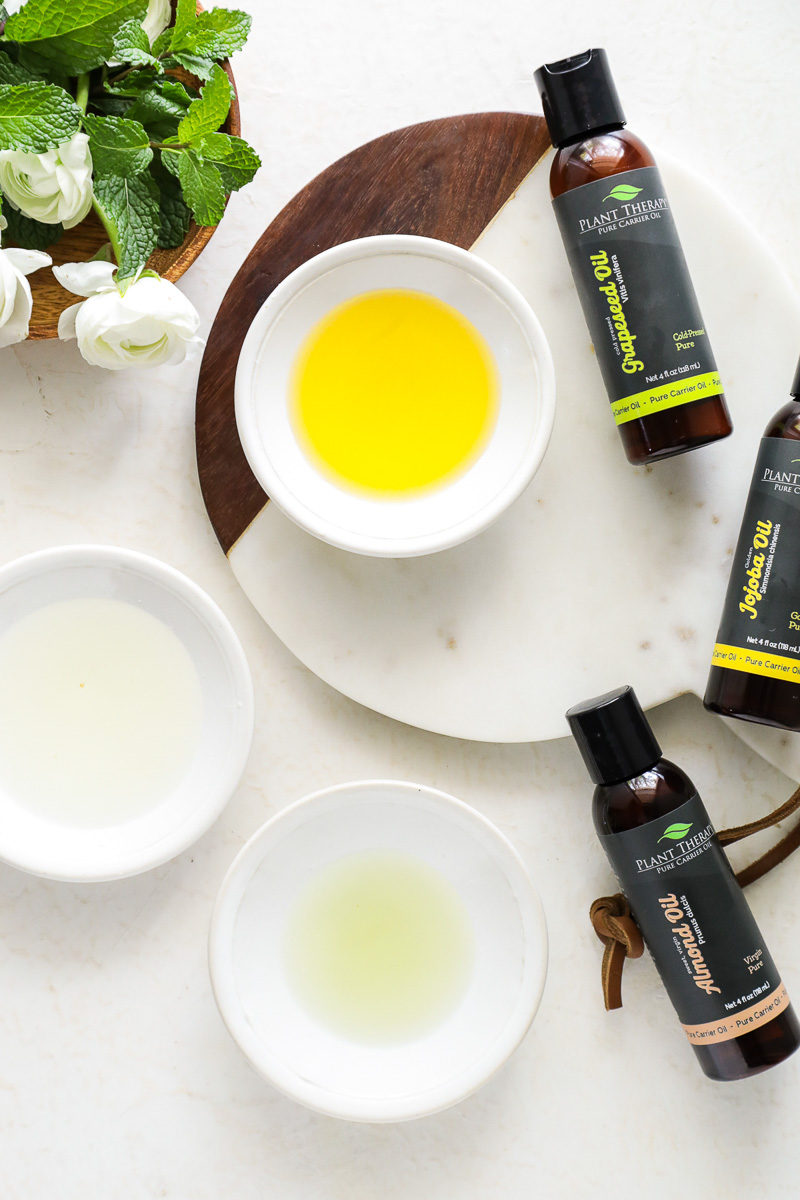
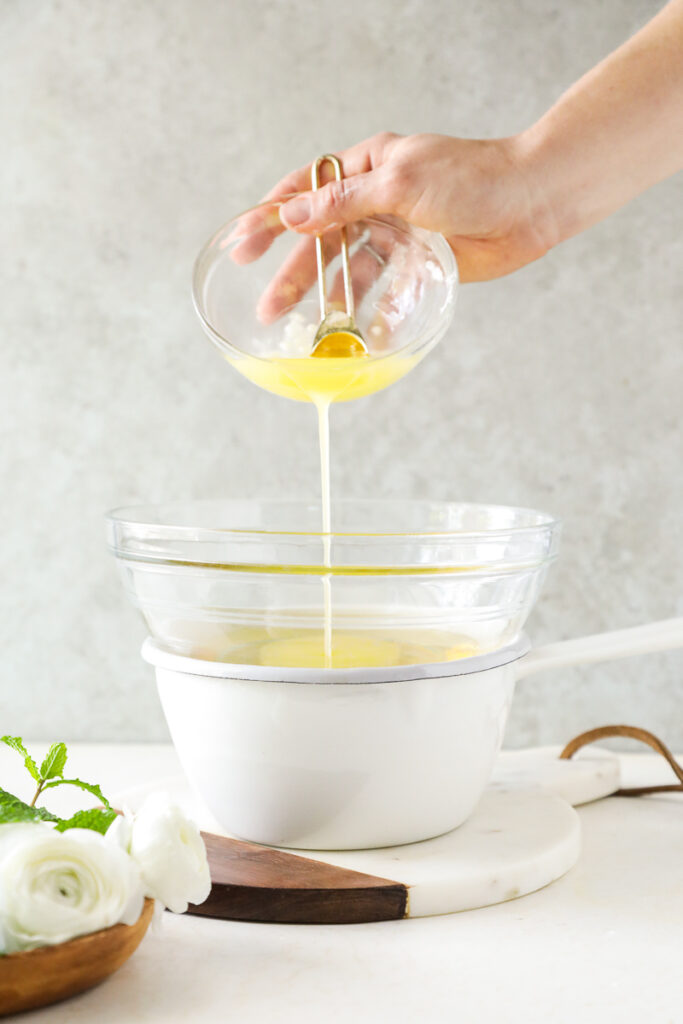
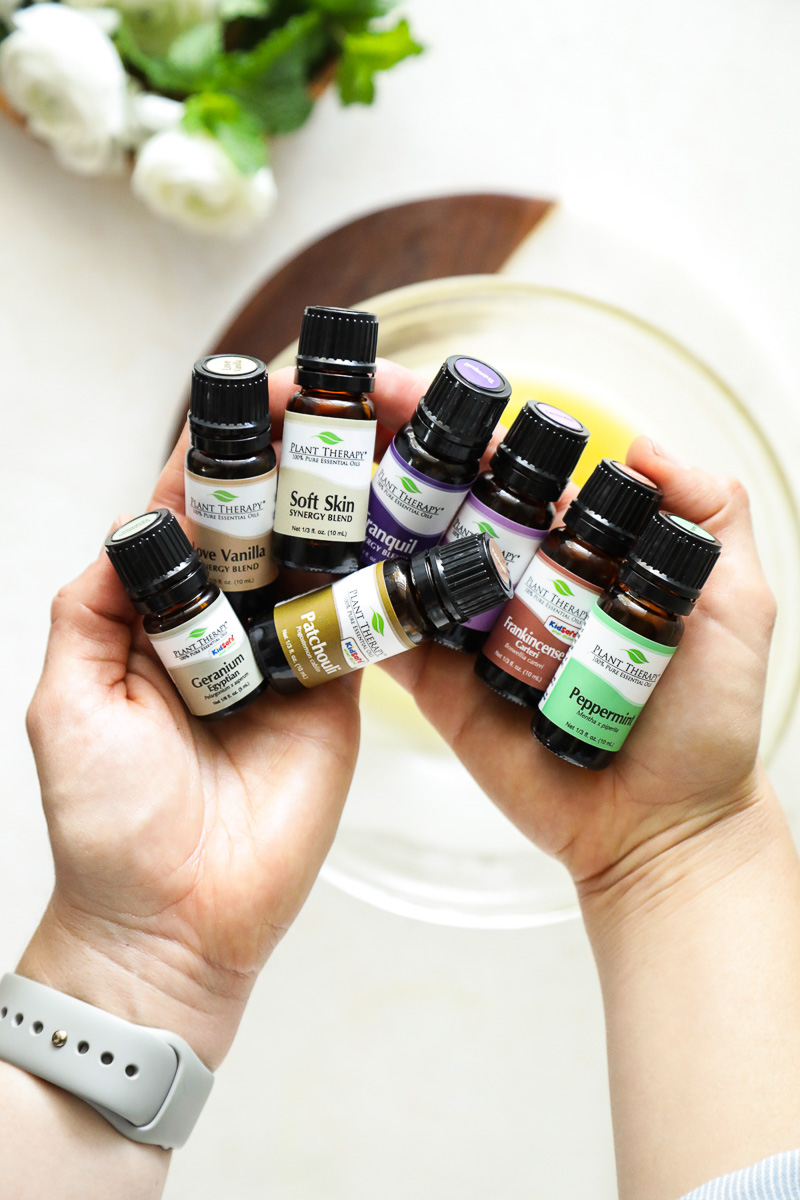
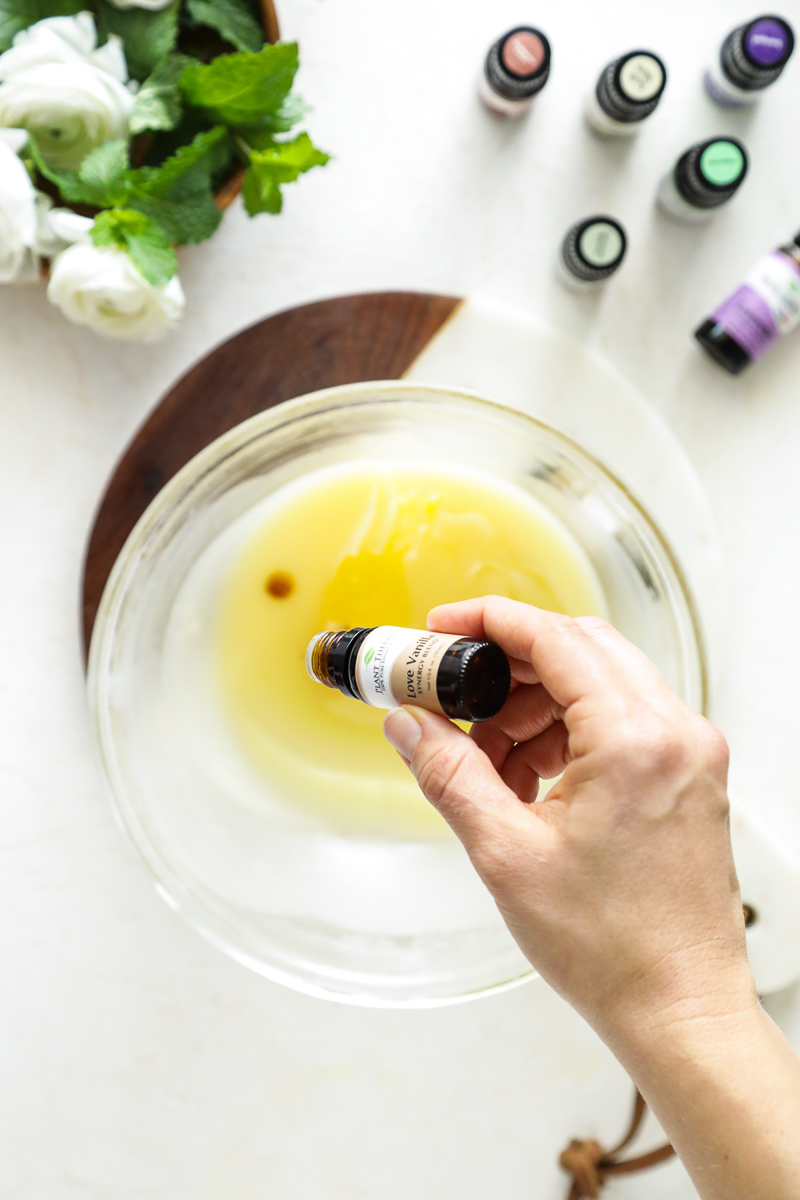
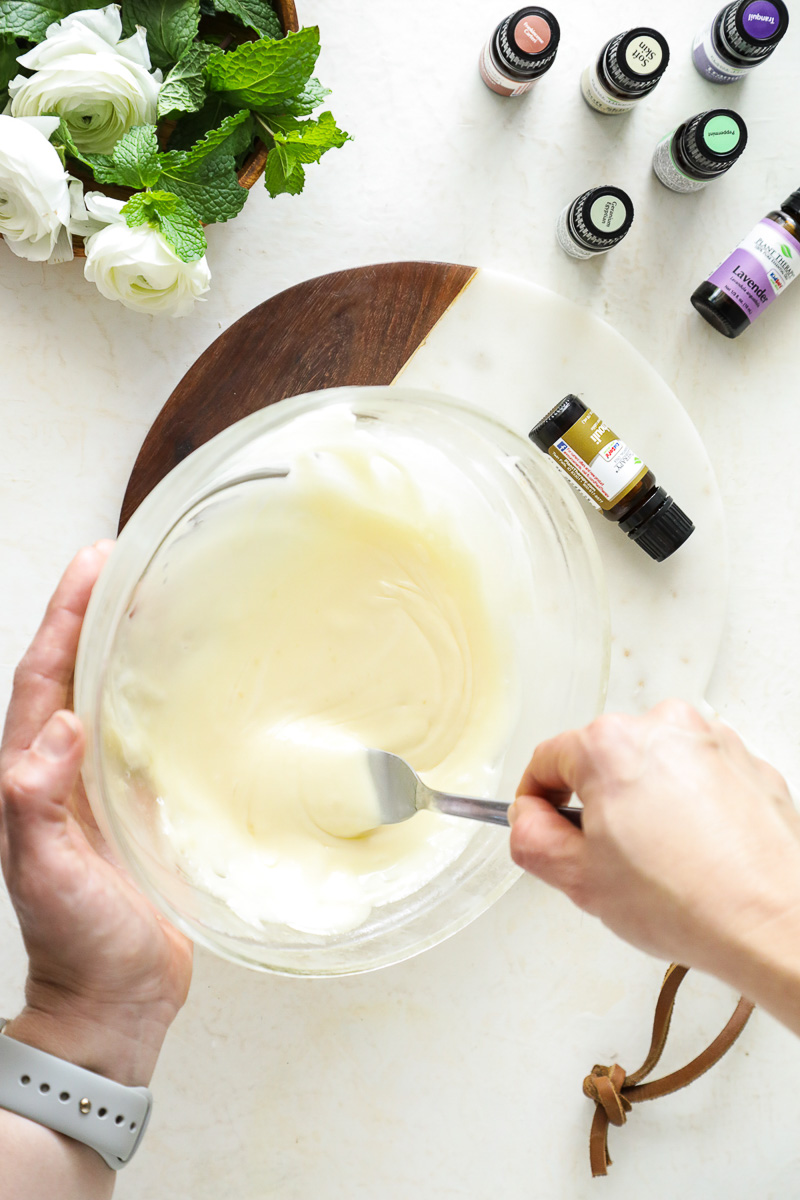
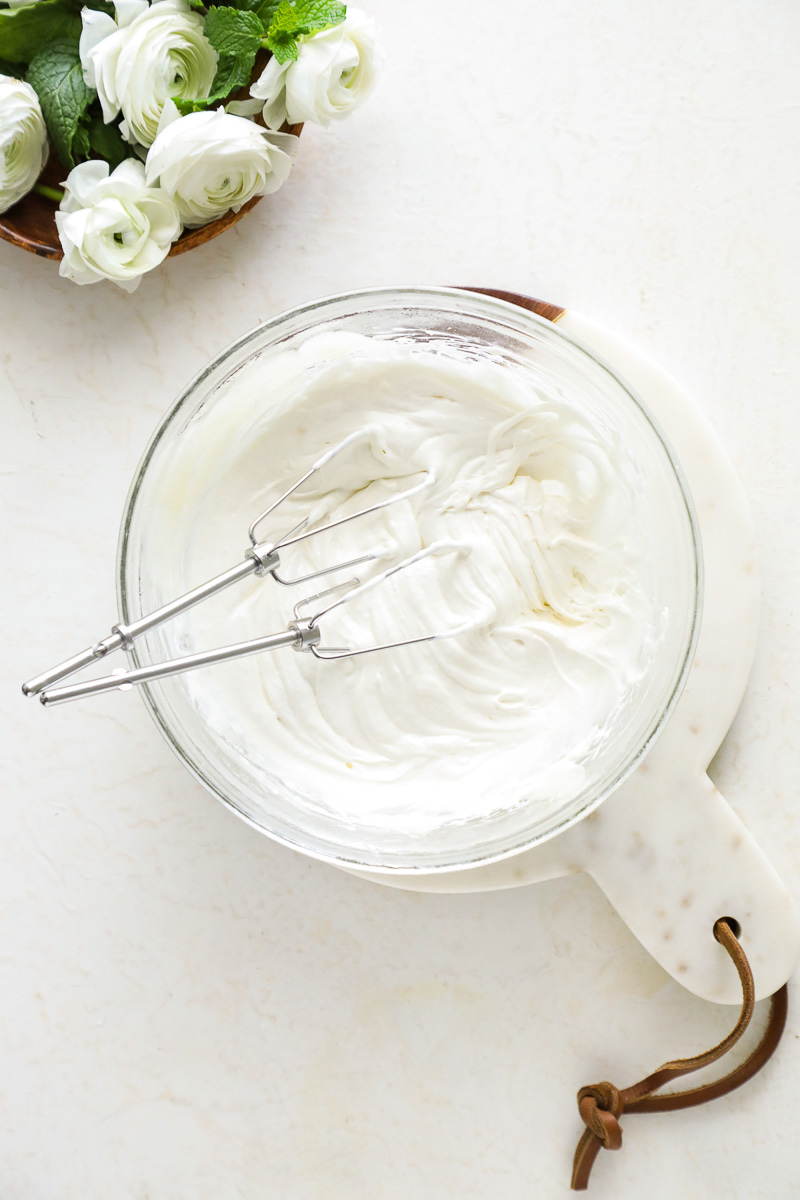

Storage: How Long Will It Last?
Store at room temperature (out of direct sunlight) in a sealed jar for up to 6 months.
What to Avoid Doing
- Don’t Use Hot Essential Oils – Some essential oils can irritate the skin and cause the skin to have a burning sensation. Avoid these “hot oils” such as cinnamon, clove, oregano, thyme, and lemongrass.
- Citrus Oils – Citrus oils, like sweet orange or lemon essential oil, are photosensitive and can make your skin more sensitive to the sun.
- Use Only a Little – If the body butter feels too oily, you’re most likely using too much. Body butter is much denser and richer than lotion (cut with water), so you don’t need much to moisturize the skin. Use a small amount, and it will absorb into the skin beautifully.
How to Prevent Hard Body Butter
If you want to create a soft, fluffier body butter, here are a few tips.
- Don’t Overwhip – When “whipping” the cooled ingredients, you only need a quick whip to create the body butter. Use a fork and whisk for 10-20 seconds for cocoa butter. For shea butter and mango butter, about 30 seconds with a hand mixer is plenty of time.
- Texture Depends on Ingredients & Temperatures – The outside temperature will affect the texture of the texture and softness of the final product. Cocoa butter will create a denser body butter. Shea butter and mango butter will create a softer final product.
- The Fluffiest Combo – Coconut oil and shea butter usually produce the fluffiest body butter.
How to Use This Product In Your Skincare Routine
Use this product anytime your skin needs moisturizing.
- Use a Small Amount – Scoop a small amount from the jar, then massage onto the skin. As you rub, the butter will melt into your skin. You only need a small amount at a time.
- Use When Skin is Damp – The best time to use this body butter is after showering when the skin is damp. Apply a small amount of product to your fingertips, then massage on the skin: arms, legs, feet, neck, and chest.
- Facial Moisturizer – This product may also be used as a moisturizer on your face. Avoid using coconut or olive oil in your formula if you plan to use it on your face. Or check out my homemade shea butter facial cream recipe.
How to Soften Body Butter Before Use: The body butter will soften or harden depending on the temperature in your home. To soften a hard body butter (which is normal and happens), place the butter in the bathroom while showering (not in direct contact with water). The hot steam of the shower will soften the body butter and make it easier to scoop out and spread on your skin.
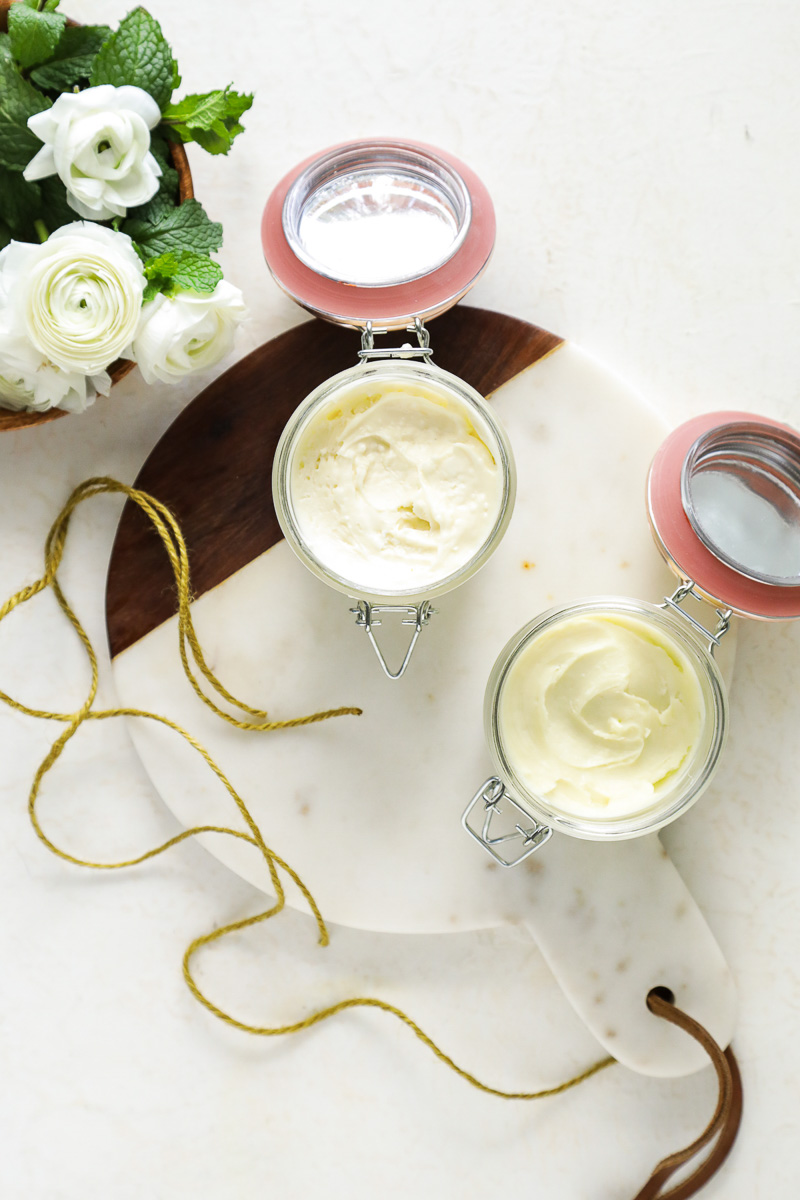
FAQs
- Do I need to use a preservative? Since water is not used to make this product, you don’t need to worry about mold or bacterial growth. Do not incorporate water into the product when scooping the butter from the jar with your hands (i.e., after a shower, washing your hands, etc.)
- You say $4-6 per jar. What size jar are you referring to? This recipe makes one 6-ounce jar. The cost will depend on the ingredients purchased.
- Can I multiply the recipe without affecting the final product? Yes, you can! You can easily double, triple, or quadruple the recipe to make multiple jars.
- Would vitamin E oil work as the carrier oil? No, vitamin E isn’t a carrier oil. You’re welcome to add a small amount of vitamin E oil if desired, but you’ll still need carrier oil.
- How long do you mix the product to avoid “over-whipping”? The answer depends on the ingredients used. For cocoa powder, just a few seconds. About 30 seconds should be enough time for shea butter and mango butter.
4 More DIY Recipes With Shea Butter
- Shea Butter Lip Balm – Use shea butter, beeswax, and oil to make a nourishing balm for chapped lips.
- Custom Lip Balm – Use any body butter of choice or oil to make this natural lip balm recipe.
- Lotion Bars – Moisturizing lotion in a solid bar, made with shea butter and beeswax.
- Face Moisturizer – Combine shea butter and oil to make an all-natural face moisturizer.
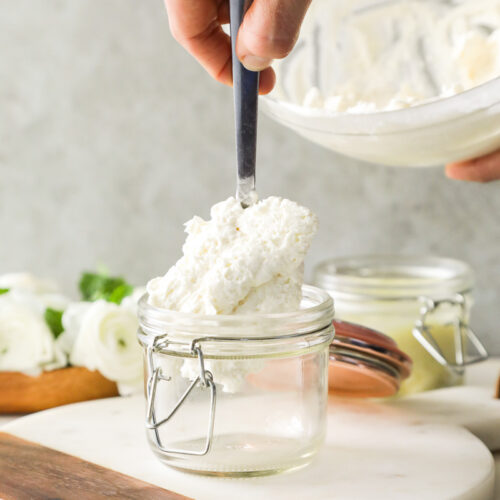
How to Make Homemade Body Butter (Non-Greasy)
Equipment
- 1 small-medium saucepan to create a double boiler and melt the butter(s)
- 1 medium glass or metal bowl big enough to rest on top of the saucepan to create a double boiler and melt the butter(s)
- 1 small bowl if using arrowroot starch to mix with the carrier oil
- 1 fork or hand-mixer to whip the body butter
- 1 glass storage jar to store the final product
Ingredients
- 1/4 cup shea butter unrefined or refined (41 grams)
- 1/4 cup mango butter or cocoa butter (41 grams mango butter or 34 grams cocoa butter or use 41 grams additional shea butter if using all shea butter)
- 1/4 cup carrier oil of choice: grapeseed oil, jojoba oil, sweet almond oil, or coconut oil (42 grams)
- 1 1/2 teaspoons arrowroot flour starch optional (5 grams)
- 36 drops essential oil of choice optional
Instructions
- First, make a double boiler: Partially fill a saucepan with water (about 1/4 the way full). Then place a glass (or metal) bowl on top of the saucepan. Place the butter(s) in the glass bowl. Turn the stove-top to medium heat, placing the double boiler on top of the heat. Allow the butter(s) to fully melt (about 3-5 minutes).
- If you're planning to use arrowroot starch/flour, in a small bowl, whisk the starch into the carrier oil of choice. Set the mixture aside. If you're not using arrowroot flour, skip this step.
- Carefully remove the glass bowl (and melted butters) from the heat source. Add the oil (with the arrowroot flour mixed in, if using), and stir to combine the ingredients.
- At this point, the mixture should be cooler (along with the bowl). If not, allow it to rest for a few minutes. Then place the bowl in the fridge and allow the mixture to solidify (about 30-60 minutes, depending on location in the fridge and fridge temperature).
- Once the mixture is opaque and a bit firm (not solid as a rock), remove the bowl from the fridge. Add the essential oil of choice, if desired.
- If you used cocoa butter, whisk the mixture with a fork until it appears "whipped." If you used shea and/or mango butters, you can use the same technique with a fork, or use a hand-mixer to "whip" the mixture. Don't over-whip!
- Spoon the whipped body butter into a glass storage jar with a lid. Place the lid on the jar. It's now ready to use. Store at room temperature (out of sunlight) for up to 6 months.
How to Use:
- Use this product anytime your skin needs moisturizing. Scoop a small amount from the jar, then massage onto the skin. As you massage, the butter will melt into your skin. You only need a small amount at a time.
- I love to use this product after bathing when my skin is still moist. I apply a small amount of product to my fingertips, then massage on my skin: arms, legs, feet, neck, chest.
Video
Notes
Natural Body-Care Simplified
Learn how to make your own body and beauty products with simple ingredients.

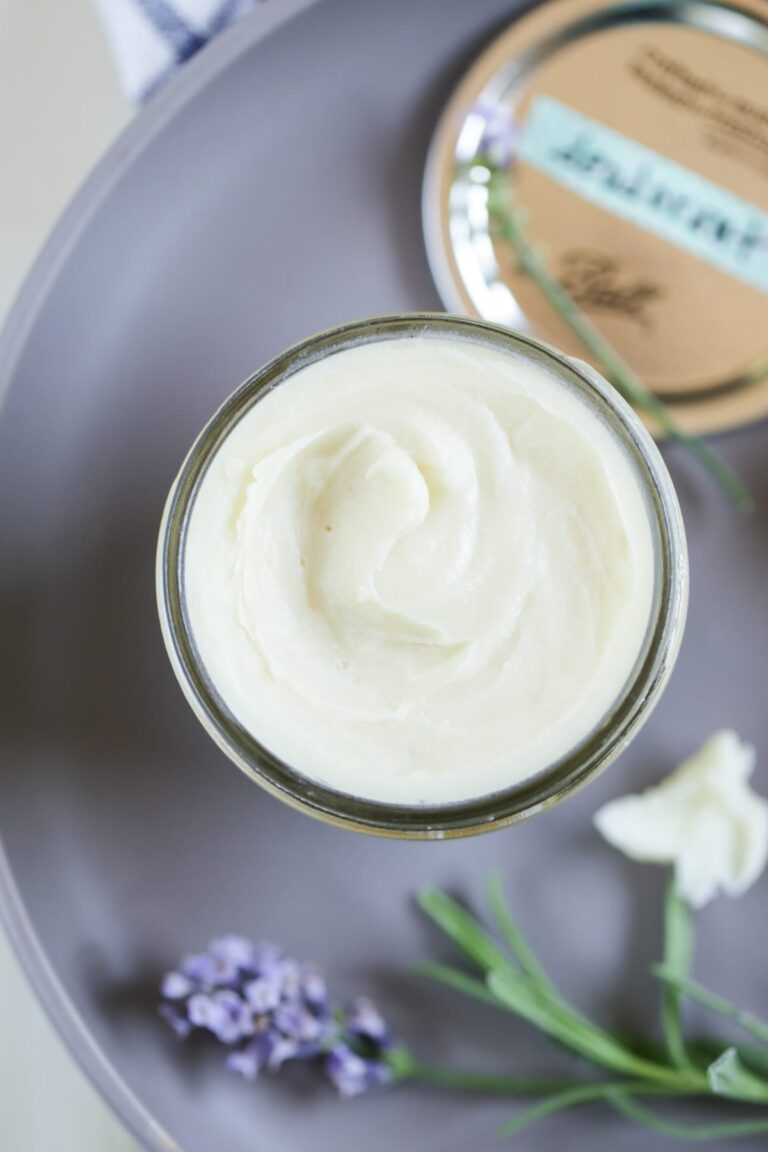
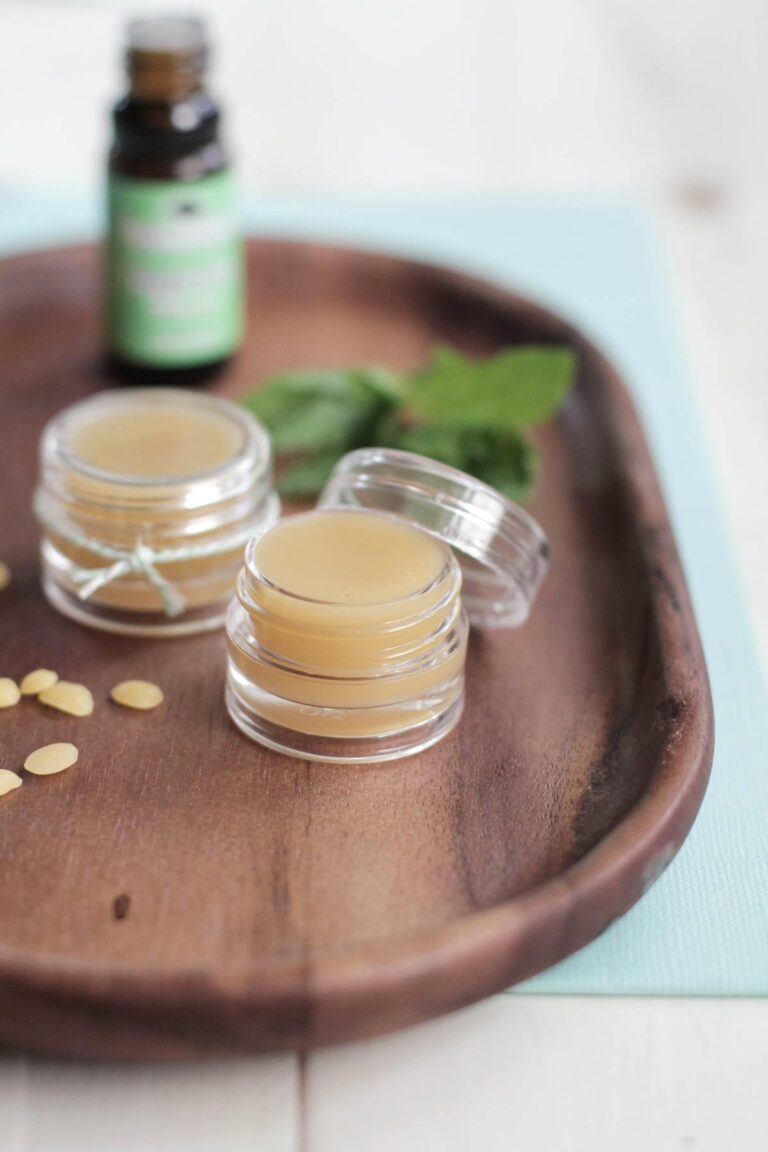
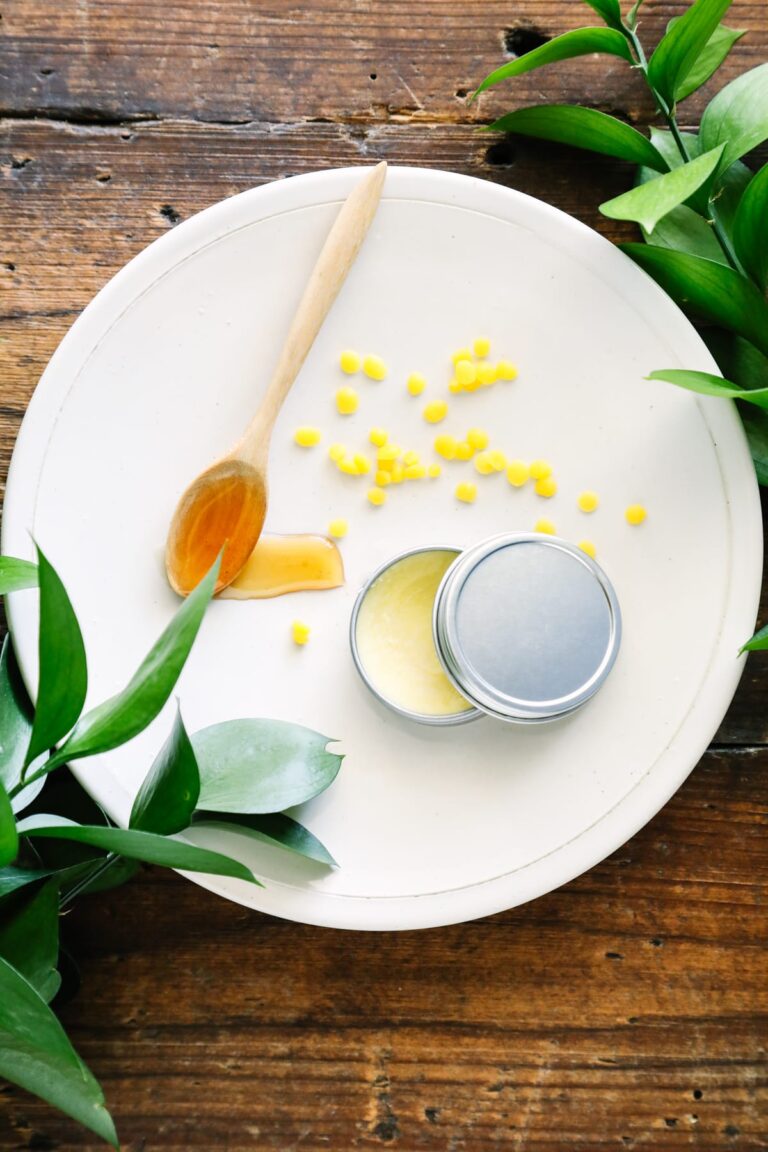
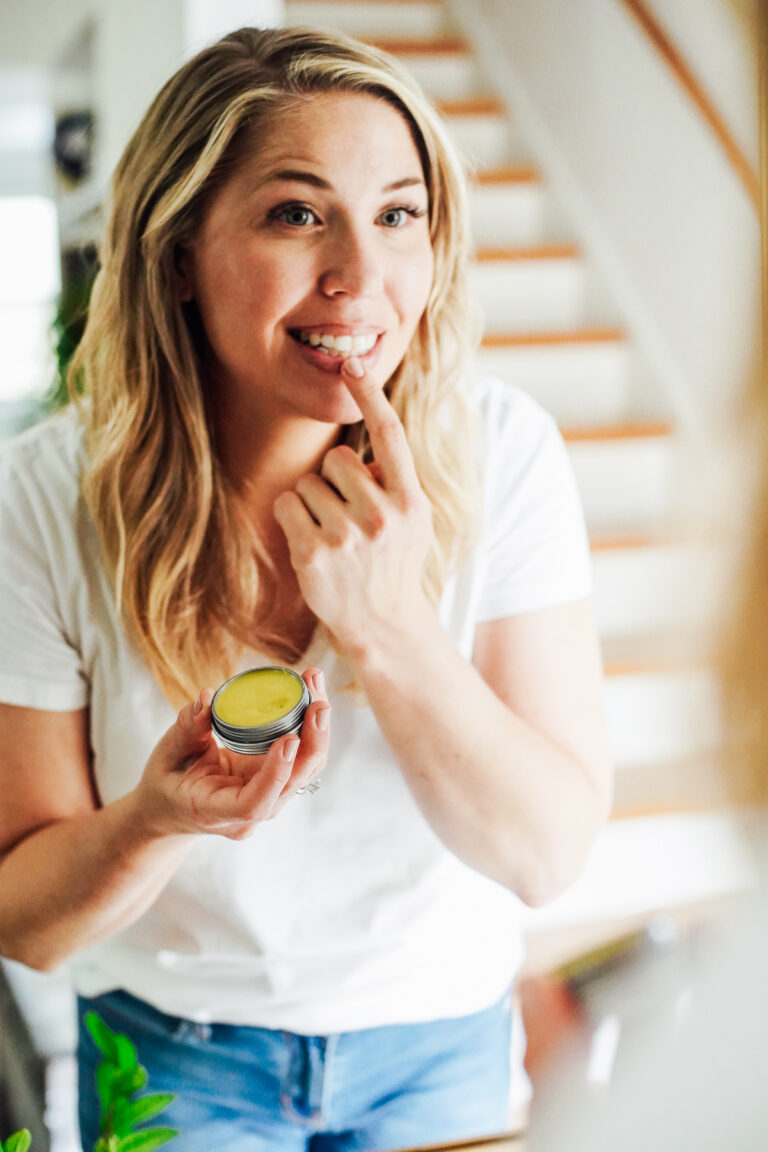
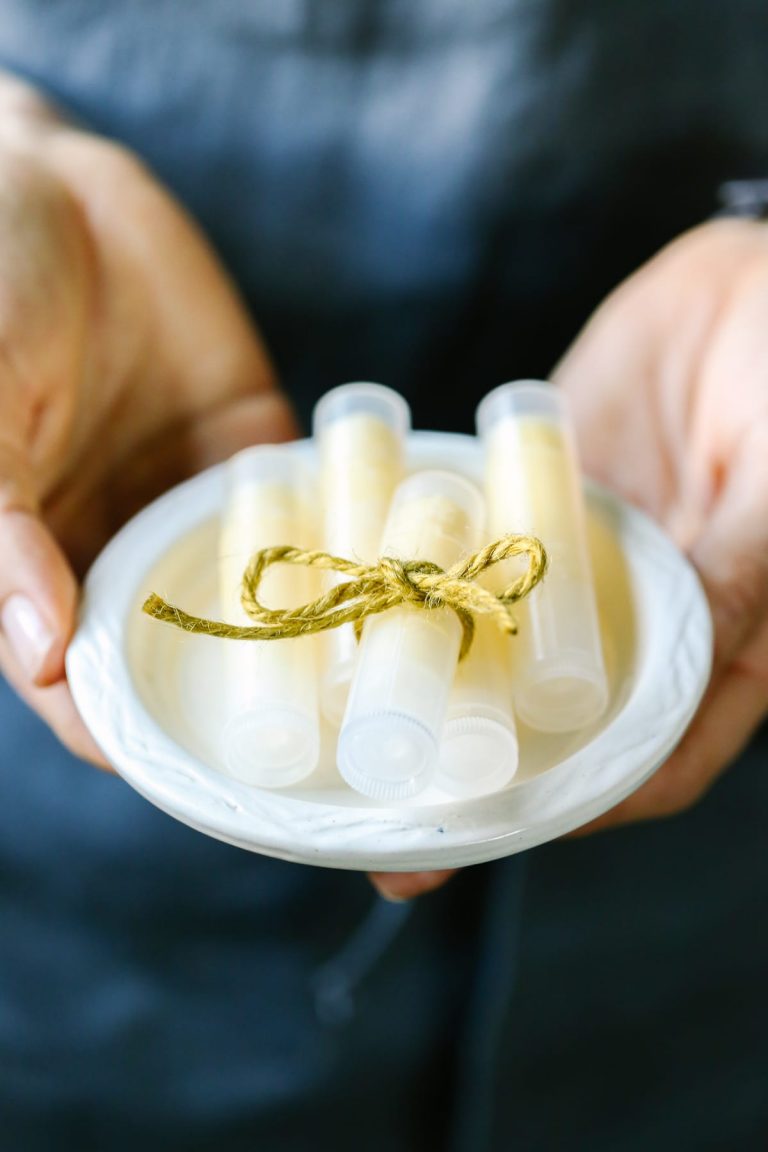
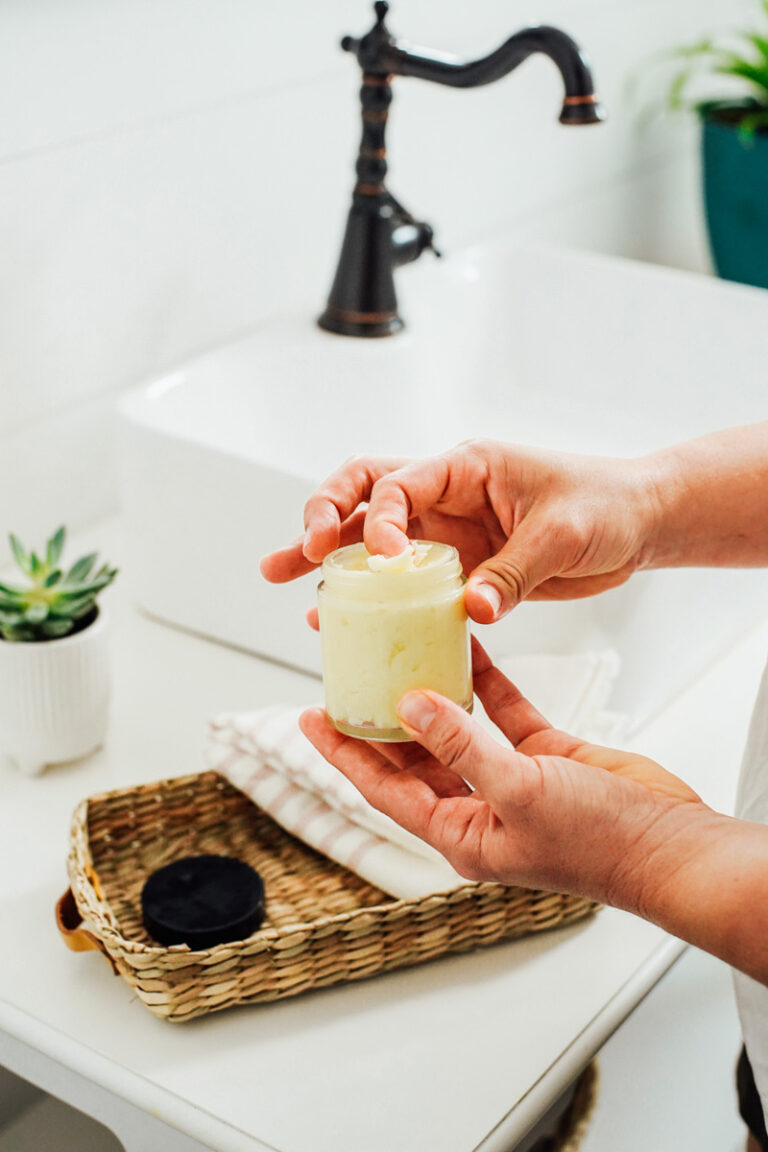
This was my first time making body butter.
I used 100% unrefined Shea butter, with a grapeseed carrier mixed with arrowroot. Before I added the EO’s, I tried it. I thought it would be too greasy, but my skin absorbed it beautifully, and my skin is glowing.
However, unrefined Shea butter has an aroma of earthy play-doh that isn’t easy to overcome.
According to manufacture instructions, my EO’s can be as high as 5%. So I added another 2% to overcome that play-doh aroma, which I achieved. I will add the additional 2% EO’s and see if it gives me the aroma I like. If not, I mix Shea butter with Cocoa butter next time.
I would recommend using a oldschool handmixer rather than a immersion blender to whip it up.
Thanks for this!
So glad you like the body butter, Carol. Great tips–thank you for sharing about unrefined shea butter.
Can I use avocado butter in stead of Shea butter
Hey Nancy, I haven’t played around with avocado butter before. As long it’s a shelf stable butter, and feels and acts similar to mango or shea butter, then yes, it should work.
Let me know if you make this recipe and how you customize it! I love using all shea butter and jojoba oil.
I tried the 6 oz recipe and love it!! I want to make a larger size. When I change the ounces, the grams in the recipe stays the same as 6 oz. The cup amount changes, but not the grams. What am I missing?
Hey Shandra, I apologize for the delayed response, I’ve been out of the country without internet the past few weeks. I think there is an issue with our recipe card and not adjusting accordingly. I’ll look into that! I’m so glad you enjoyed the recipe. You can double of triple the amounts as needed.
Can kids above the age of 8 years use this body butter??… would beeswax prevent it from melting in extreme hot temperatures, as the temperature in summer here goes upto 38 degrees Celsius,??.. if I have to add beeswax can you let me know the amount please..thank you.
Hey Rachana, This body butter should hold up just find in the summer. If you want to add beeswax, it will make it very hard. I would use just a couple of teaspoons. It is safe to use on kids, just skip the essential oil or use a kid-safe essential oil.
Just wondering if I can substitute cornstarch for the arrowroot? Don’t know if this was asked already, but there are so many comments, which I love to read, but didn’t want to scroll through all. Great recipe. I am making today!
Hey Nancy, Yes, you can :).
How much does this yield?
Hey Brian, This body butter recipe yields 6 ounces.
Has anyone done the math to find out the cost analysis of making the body butter? Like how much it costs per ounce or container of 6 ounces?
Hey Stephanie, I haven’t done a specific breakdown. It will depend on the brands you use for the shea butter, etc. I do know it’s much cheaper than any of the truly natural body butters in the store which can cost about $12.99 upward. There is also the time factor, too. So it really comes down to if you enjoy making it and is it worth the extra time to save a few dollars, IMO. Maybe someone else can chime in with how much it’s costing them.
How can you keep body butter from separating and melting in heat?
TIA
Hey Kim, You can store in the fridge if needed. We live in Florida and I haven’t had an issue with it melting yet.
Hi. I have been making besrd oils and facial serums for a while. I now expanded to bodybutters. Your advice and suggestions came in really handy. I mostly use shea butter as a base. But one issue is I cannot seem to get my mixture as fluffy and creamy like your pictures. Am I mixing too long or perhaps the wrong speed. I have one of those hand held mixers. Could you pleasy advise? Many thanks
Hey, I’ve found over mixing can cause that issue or mixing it too fast. Keep in mind, most body butters will harden up, so they won’t stay “whipped” like whipped topping.
Dear Kerstin. I have also read similar recipes and made a few myself. I also saw one where the use the shea butter without melting it. Only using a hand blender mixing the shea butter and carrier oils with tapioca powder snd then whisking in the essential oils. What are your thoughts about this method? Also, what would your recommended ratio of shea butter to carrier oil be? 80% shea to 20% oil? Thanks for all the tips.
You can try that—not melting the butter. Not sure how it will turn out. You can play around with the ratio that works best for you. The amounts provided in the recipe are what I like best.
LS Team
hey. I have started prepping to make this recipe, only question I have is what volume is produced from the whipped product?
I have a 230 ml container will that do?
The recipe makes 6 ounces of body butter.
Hey again! Quick question since this is u.s measurement can I use the same measurements but uk version instead of converting them so for example it is 42g instead of finding out how many grams that would be in uk can I just use 42g in uk measurement or would that effect the batch sorry kinda over explained !
Hey Lydia, Grams are universal, so it shouldn’t change.
I love this recipe, Thanks
Thank you, Sophia!
Hi there would you kindly send me your lip balm recipe please, i have made this many times and given it to many of my friends who keep asking for more, i have misplaced the lip balm recipe and cannot find it anywhere.
Kind Regards Terry
Hey Terry, Here’s the lip balm: https://livesimply.me/how-to-make-a-simple-ingredient-lip-balm/ An easy way to find it next time is to search on Google: Live Simply lip balm.
When it says 42g of plant carrier oil does it mean since your using two oils 42g each or alltogether so 14g each if your using three oils
Hey Lydia, 42 grams of a carrier oil total. You can use one oil or divide this between a couple of different oils: avocado and olive oil for example.
Hi just in case it comes in contact with water which preservative would I use and how much
Hey Tamisha, Water shouldn’t be added to this recipe, so no preservative is needed.
Hi all,
please need an advice, while I was making the body butter, after melting shea butter and coconut oil at the bottom of the bowl I saw lots of black dirts floating about, how can I filter the dirt out, the product cannot be used, before I started to make the product I washed everything throughly and let it dry. I believe the dirts is in the product itself like shea butter or coconut oil.
Please advise many thanks …
Hi there,
I’m not sure what the black dirt would be. I would contact the brand for the oil or butter and ask them what they think.
LS Team
How many grams is 1/2 cup shea butter please? We don’t use cup measurements here in the UK. Thank you! Looking forward to trying this as my first homemade body butter!
Hi Rachael,
64 grams is half a cup 🙂
LS Team
I’m a newbie so I’m a little confused about how much essential oil to add. The recipe says 36 drops of essential oil but there is a note that mentions you do a 1% dilution. I’m not understanding what you mean by that. I want to make sure I do this correctly so it is safe to use on my skin. Is it 36 drops straight from the essential oil bottle or are you diluting it with something? Sorry, I don’t mean to sound like I’m stupid but I have never made my own bath and body products and the essential oil part is intimidating I’m scared to add the essential oils. I’m concerned that I may add too much essential oil and cause a skin irritation. Am I making this harder than it actually is??? (LOL) Your advice is greatly appreciated! Thank you! 🙂
Hey Leigh, Great question! Dilution can be tricky to figure out at first. This is drops from the EO bottle into the mixture. This is based on how much carrier oil you’re using (what the essential oil is being diluted with/in) and also how much of an essential oil is considered safe to use (some essential oils can be used at a higher or lower dilution percentage). The 36 drops is based on this recipe, so I just add a note to let people know how much this is (1% dilution rate). This post explains more about dilution: https://blog.planttherapy.com/blog/2018/09/11/how-to-dilute-essential-oils-a-comprehensive-guide/